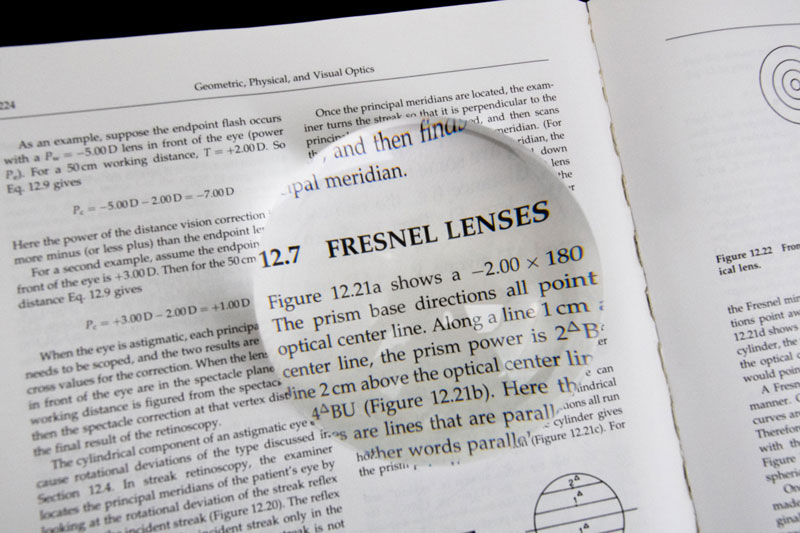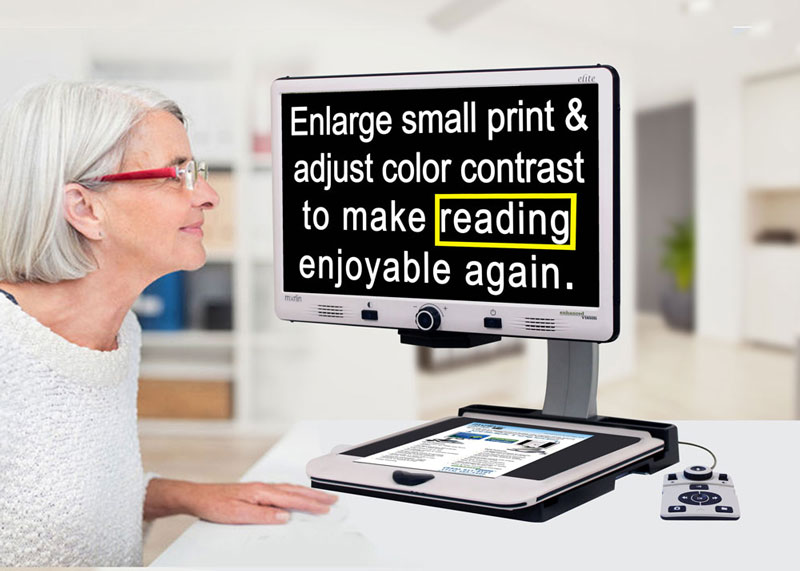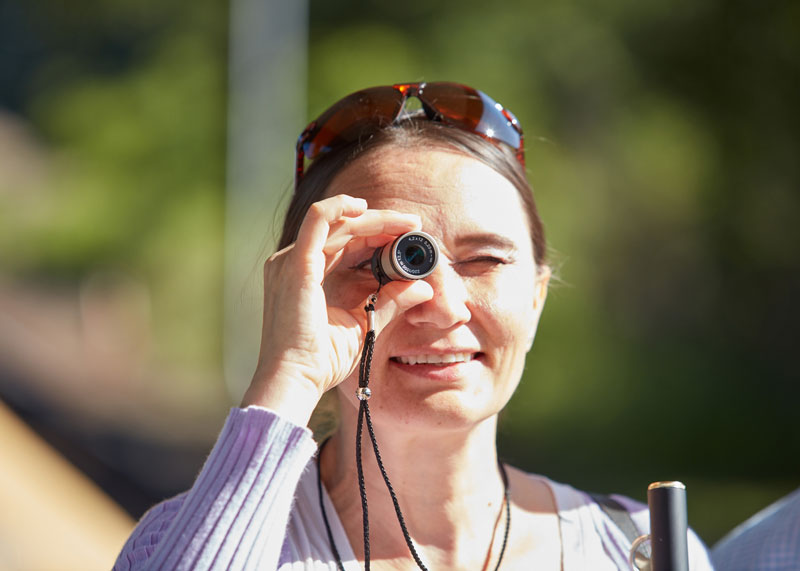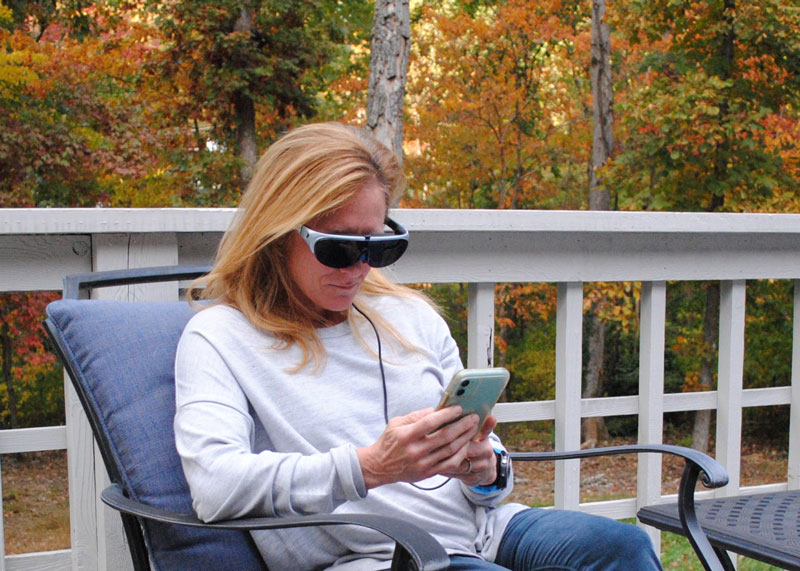Low Vision Devices

Devices to Help Manage Low Vision
Low vision patients can maximize their remaining vision and develop strategies that lead to a more independent lifestyle by using low vision aids. The main principles behind low vision devices are to enhance contrast, control glare and magnify objects using various tools.
Most people use multiple low vision aids because each is designed to serve a very specific purpose.
Types of Low Vision Devices
Hand-held magnifiers
Hand-held magnifiers are convenient for short-term near-vision tasks such as reading menus, price tags and pill bottles. These helpful devices are very portable, versatile and economical. They are available with and without built-in lights for better visibility. They must be held at the proper distance to provide the clearest image. It is important to understand that the stronger the magnifier, the smaller the lens and viewing area will be. This makes selecting the proper power for their intended use very important in making the right purchasing decision. A low vision specialist can customize the combination of the magnifier and one’s eyeglasses to provide the best possible results.

Stand magnifiers
Stand magnifiers are similar to hand magnifiers in their use and purpose but do not have to be held in the proper position. They are perfect for extended periods of use, including reading and writing or even sewing and crafts. As with hand magnifiers, stand magnifiers are available with and without lights. Illuminated stand magnifiers provide additional light to the object being magnified, helping to increase visibility. These magnifiers are often portable and lightweight.

Magnifiers that can be worn
Head-worn or hands-free magnifying devices allow wearers to see magnified images through a pair of eyeglasses, visor or other lens types. These aids are intended for near viewing activities that may require both hands to be free such as sewing, crafts or small household repairs.
Hands-free magnifiers are available in a selection of options, including versions that can be worn around the head, neck or clipped onto glasses. While this group of aids are portable, they are best suited to be used while engaged in stationary activities.

Spectacle microscopes
Spectacle microscopes are eyeglasses that contain a high-powered magnification lens for use by one eye. They allow the user to hold the material very close to their eye to achieve a high level of magnification (like a Jeweler’s loupe). They are typically used rather than holding a hand magnifier for reading or other near tasks where the hands need to be free.
Magnifying eyeglasses
Special eyeglasses that provide magnification are a frequently prescribed option for people with low vision. They are usually much higher in power than what is available in stores as readymade readers. These can be designed for use at different working distances based upon the individual’s level of vision and their activity goals. These magnifying glasses can be prescribed as a single power lens or as bifocals and can include treatments to reduce glare or darken for use out of doors.

Hand and stand video magnifiers (CCTVs)
Closed-circuit televisions (CCTVs), now more commonly referred to as video magnifiers or electronic magnifiers, are available in a variety of designs—handheld, tabletop, and even wearable (video headset) versions. The classic desktop CCTV magnifier can be compared to a microfiche machine often seen in a public library where the reading material is placed beneath a camera and an enlarged image of it appears on the monitor screen above. Video magnifiers act similarly to other low vision devices in that they enlarge the image of an object so that it is easier to see.

Telescopes and bioptics
Telescopes, like binoculars, allow the user to see further away. For low vision applications telescopes can be prescribed as hand-held (monoculars) or mounted into a pair of eyeglasses (bioptics). They can be prescribed for one or both eyes and are available in fixed focus, manually focusable and autofocus versions. They are available in a range of powers and designs and their selection should be advised by the low vision specialist.
They are best used when stationary such as when watching television or at the theater. A bioptic telescope is mounted in the top portion of a pair of glasses and in some states, these are permitted to help people spot distant road signs, etc., when driving, among other tasks.
Magnifiers that contain only a single lens, whether they are handheld, stand or mounted into eyeglasses require that the material viewed be held at the focal length of the lens—usually very close to the eye. This may not be comfortable or natural for longer activities. Focusable telescopes can be adjusted for use at almost any distance from up close to very far away and hence, can allow the activity to be performed at more natural working distances.
In 47 states in the U.S., eligible visually impaired persons may be allowed to drive using bioptic telescope eyeglasses. These bioptic devices allow the driver to see further up the road to see signs, signals, other traffic and road obstacles sooner and give them more time to adjust their driving appropriately. The user drives looking through the regular eyeglass lenses most of the time and dips their head slightly to sight through the telescope when necessary, similar to the use of the side and rearview mirrors. The licensing process and regulations regarding driving with a bioptic device vary from state to state and must be done in conjunction with an optometrist familiar with prescribing bioptic telescopes. The low vision specialist will determine if the individual will be able to comply with the state’s bioptic driving requirements and would be successful with the device.

Low vision sunglasses
Many people with low vision have reduced contrast sensitivity which is the ability to separate an object from its background. This can make it difficult to see the edges of steps, curbs, etc. The use of tinted lenses, either worn alone or over prescription eyewear, makes it easier to see and clears up that “foggy vision” that frequently occurs with low vision. Typical tint colors include yellow, amber, gray, and plum. Some tints are also polarized, which improves contrast vision and makes it easier to see steps and curbs because yellow and orange increase contrast vision. In other cases, some people with specific types of color vision problems may benefit from wearing green or blue lenses. Testing by a low vision specialist will help determine the best color(s) and filter intensities for the individual.

Head mounted digital glasses (HMDs)
A newer category of digital low vision aids is called head-mounted displays (HMDs). These devices, adapted from virtual reality glasses intended for gaming and other technology applications, contain special software for the low vision user to magnify images, control contrast and brightness and may offer other technologies to enhance their helpfulness to the user. They can be used to see at virtually any distance and as a result, can address a range of visual activities.

Low vision apps for your mobile phone
Whether you use an Apple or Android phone, an increasing number of mobile apps are available to help individuals with low vision. The functions can range from simple magnifiers to enhancing the visibility of digital images. Some include options to help the user identify doors and objects and even connect to a sighted person to help one find their way or successfully finish a task. Some common uses include: identifying money, reading small or low contrast print, reading menus or signs from a distance, navigating and identifying street signs, watching sporting events, identifying grocery store items or completing paperwork.
